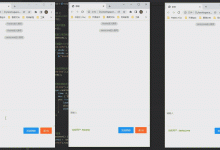上次成功通过FFmpeg采集麦克风的PCM数据,这次针对上一次的程序进行了改造,使用AAC编码采集后的数据。
(传送门) JavaCV FFmpeg采集麦克风PCM音频数据
采集麦克风数据是一个解码过程,而将采集后的数据进行AAC编码则是编码过程,如图: 从上图可以看出,编码过程,数据流是从AVFrame流向AVPacket,而解码过程正好相反,数据流是从AVPacket流向AVFrame。
从上图可以看出,编码过程,数据流是从AVFrame流向AVPacket,而解码过程正好相反,数据流是从AVPacket流向AVFrame。
javacpp-ffmpeg依赖:
<dependency><groupId>org.bytedeco.javacpp-presets</groupId><artifactId>ffmpeg</artifactId><version>${ffmpeg.version}</version></dependency>
FFmpeg编码的过程是解码的逆过程,不过主线流程是类似的,如下图:

基本上主要的步骤都是:
- 查找编码/解码器
- 打开编码/解码器
- 进行编码/解码
在FFmpeg的demo流程中其实还有创建流
avformat_new_stream()
,写入头部信息
avformat_write_header()
和尾部信息
av_write_trailer()
等操作,这里只是将PCM数据编码成AAC,所以可以暂时不需要考虑这些操作。
将采集音频流数据进行AAC编码的整体流程主要有以下几个步骤:
- 采集音频帧
- 将视音频帧重采样
- 构建AAC编码器
- 对音频帧进行编码
采集音频帧
采集音频流中的音频帧在上一次采集PCM数据的时候已经实现了,主要是从AVFormatContext中用
av_read_frame()
读取音频数据并进行解码(
avcodec_decode_audio4()
),实现代码如下:
public AVFrame grab() throws FFmpegException {if (av_read_frame(pFormatCtx, pkt) >= 0 && pkt.stream_index() == audioIdx) {ret = avcodec_decode_audio4(pCodecCtx, pFrame, got, pkt);if (ret < 0) {throw new FFmpegException(ret, "avcodec_decode_audio4 解码失败");}if (got[0] != 0) {return pFrame;}av_packet_unref(pkt);}return null;}
这样通过grab()方法就可以获取到音频流中的音频帧了。
音频帧重采样
在进行AAC编码之前,如果采集的音频帧信息格式跟编码器信息不一致则需要进行重采样,用到的是FFmpeg的
SwrContext
组件,下面的
AudioConverter
是对
SwrContext
封装的组件,内部实现了AVFrame的填充及
SwrContext
的初始化,使用方式如下:
// 1. 创建AudioConverter,指定转化格式为AV_SAMPLE_FMT_S16AudioConverter.create(src_channel_layout, src_sample_fmt, src_sample_rate,dst_channel_layout, AV_SAMPLE_FMT_S16, dst_sample_rate, dst_nb_samples);// 2. 对音频帧进行转化swr_convertconverter.convert(pFrame);
AudioConverter的convert方式,实际上也是调用了SwrContext的swr_convert方法:
swr_convert(swrCtx, new PointerPointer<>(buffer), bufferLen, pFrame.data(), pFrame.nb_samples());
构建AAC编码器
进行AAC编码之前需要构建AAC编码器,根据上面的流程图利用
avcodec_find_encoder()
和
avcodec_alloc_context3()
实现编码器的创建和参数配置,最后用
avcodec_open()
打开编码器,完整的初始化代码如下:
public static AudioAACEncoder create(int channels, int sample_fmt, int sample_rate, Consumer<byte[]> aacBufConsumer, Map<String, String> opts) throws FFmpegException {AudioAACEncoder a = new AudioAACEncoder();// 查找AAC编码器a.pCodec = avcodec_find_encoder(AV_CODEC_ID_AAC);if (a.pCodec == null) {throw new FFmpegException("初始化 AV_CODEC_ID_AAC 编码器失败");}// 初始化编码器信息a.pCodecCtx = avcodec_alloc_context3(a.pCodec);a.pCodecCtx.codec_id(AV_CODEC_ID_AAC);a.pCodecCtx.codec_type(AVMEDIA_TYPE_AUDIO);a.pCodecCtx.sample_fmt(sample_fmt);a.pCodecCtx.sample_rate(sample_rate);a.pCodecCtx.channel_layout(av_get_default_channel_layout(channels));// 音频参数设置a.pCodecCtx.channels(av_get_channel_layout_nb_channels(a.pCodecCtx.channel_layout()));a.pCodecCtx.bit_rate(64000);// 其他参数设置AVDictionary dictionary = new AVDictionary();opts.forEach((k, v) -> av_dict_set(dictionary, k, v, 0));a.ret = avcodec_open2(a.pCodecCtx, a.pCodec, dictionary);if (a.ret < 0) {throw new FFmpegException(a.ret, "avcodec_open2 编码器打开失败");}// 填充音频帧a.aacFrame = av_frame_alloc();a.aacFrame.nb_samples(a.pCodecCtx.frame_size());a.aacFrame.format(a.pCodecCtx.sample_fmt());a.aacFrameSize = av_samples_get_buffer_size((IntPointer) null, a.pCodecCtx.channels(), //a.pCodecCtx.frame_size(), a.pCodecCtx.sample_fmt(), 1);// pCodecCtx.sample_fmt() = S16// AutoCloseablea.buffer = new BytePointer(av_malloc(a.aacFrameSize)).capacity(a.aacFrameSize);avcodec_fill_audio_frame(a.aacFrame, a.pCodecCtx.channels(), a.pCodecCtx.sample_fmt(), a.buffer, a.aacFrameSize, 1);a.pkt = new AVPacket();a.pcmBuffer = new byte[DEF_PCM_BUFFER_SIZE];a.aacBuffConsumer = aacBufConsumer;return a;}
这里需要特别注意的是,不是每一帧pcm数据都能编码成为一帧AAC音频帧,所以这里通过
Consumer<byte[]> aacBufConsumer
指定回调来消费编码完成的AAC音频帧。
对音频帧进行编码
编码器构建完成后就可以对音频帧进行编码了,入参为AVFrame,出参通过
Consumer<byte[]> aacBufConsumer
指定回调输出byte[],就如上面提到,不是一帧PCM音频数据就能编码成一帧AAC数据,所以这里需要就多帧pcm音频帧进行编码,并缓存未编码的pcm数据留到下一次编码。
public void encode(AVFrame avFrame) throws FFmpegException {// 计算Pcm容量int size = AudioUtils.toPcmFrameSize(avFrame, pCodecCtx.channels(), pCodecCtx.sample_fmt());byte[] buff = new byte[size];avFrame.data(0).get(buff);System.arraycopy(buff, 0, pcmBuffer, offset, size);offset += size;capacity += size;while (capacity >= aacFrameSize) {byte[] aacBuf = new byte[aacFrameSize];System.arraycopy(pcmBuffer, 0, aacBuf, 0, aacFrameSize);aacFrame.data(0).put(aacBuf);// 减去已经用于编码的buffcapacity -= aacFrameSize;offset = capacity;if (capacity > 0) { // 如果还有剩余,则放入buffer最前面byte[] lBuff = new byte[capacity];System.arraycopy(pcmBuffer, aacFrameSize, lBuff, 0, capacity);System.arraycopy(lBuff, 0, pcmBuffer, 0, capacity);}ret = avcodec_encode_audio2(pCodecCtx, pkt, aacFrame, got);if (ret < 0) {throw new FFmpegException(ret, "avcodec_encode_audio2 音频编码失败");}if (got[0] != 0) {byte[] pktBuff = new byte[pkt.size()];pkt.data().get(pktBuff);if (aacBuffConsumer != null) {aacBuffConsumer.accept(pktBuff);}av_packet_unref(pkt);}}}
最后只需要调整一下上一次的主程序,将读取pcm数据的部分,调整为将AVFrame丢进编码器,拉取byte数组即可。
public static void main(String[] args) throws FFmpegException, FileNotFoundException {FFmpegRegister.register();AudioGrabber a = AudioGrabber.create("External Mic (Realtek(R) Audio)");FileOutputStream fos = new FileOutputStream(new File("s16.aac"));AudioAACEncoder encoder = AudioAACEncoder.create(a.channels(), a.sample_fmt(), a.sample_rate(), buff -> {try {fos.write(buff);} catch (IOException e) {e.printStackTrace();}});for (int i = 0; i < 100; i++) {encoder.encode(a.grab());}encoder.release();a.release();}
最终采集编码后的AAC数据可以用VLC播放:

这里对比一下,同样的100帧pcm数据和aac数据的大小,相差还是很大的。

=========================================================AAC编码源码可关注公众号 “HiIT青年” 发送 “ffmpeg-aac” 获取。(如果没有收到回复,可能是你之前取消过关注。)
 关注公众号,阅读更多文章。
关注公众号,阅读更多文章。
 爱站程序员基地
爱站程序员基地


